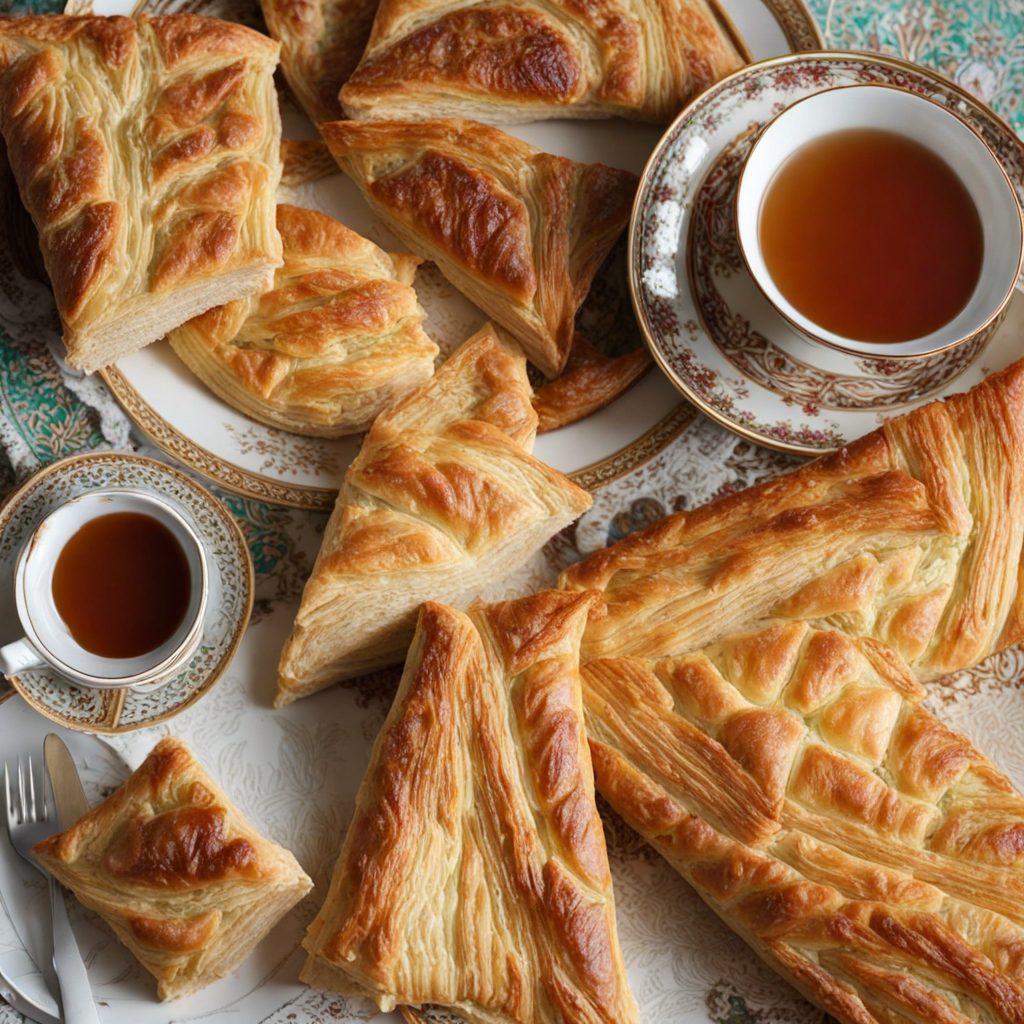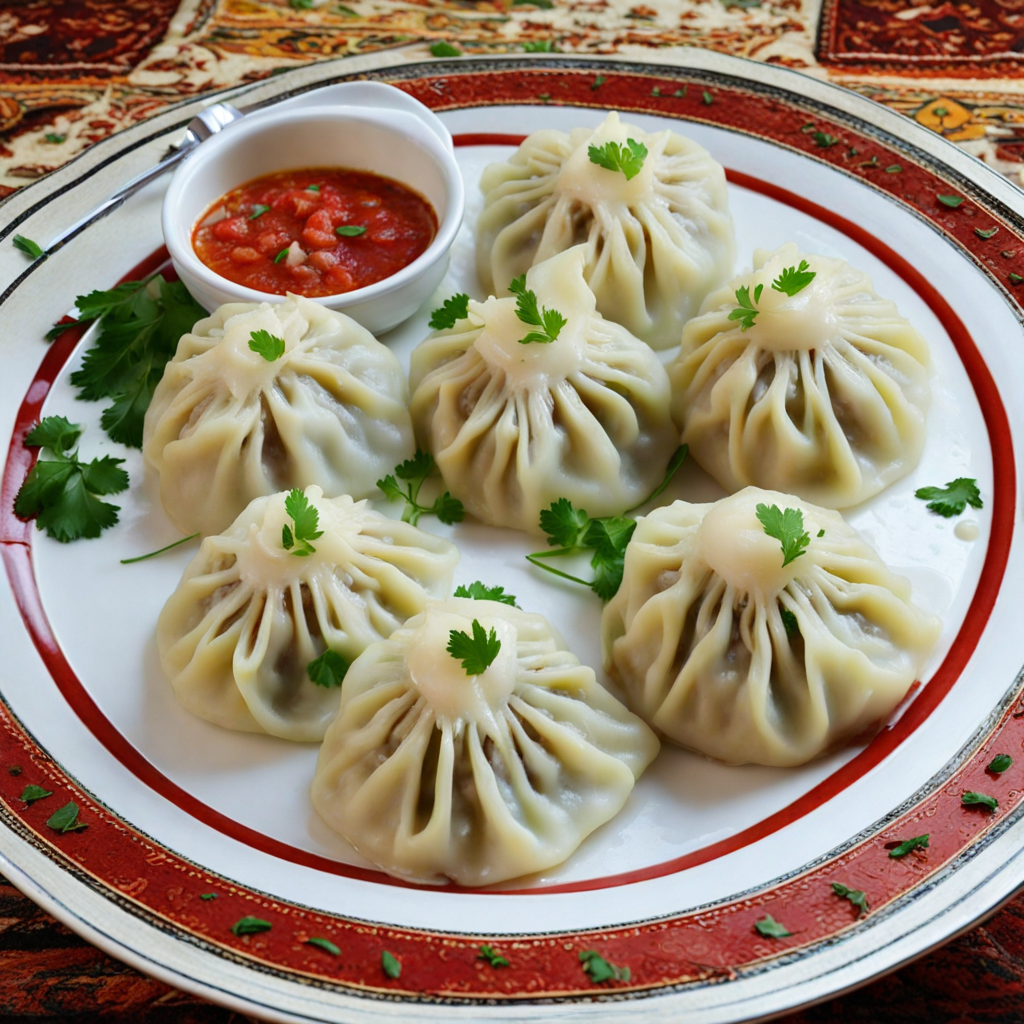Fatir
Fatir is a traditional Tajik pastry that embodies a delightful combination of rich flavors and textures. This flaky, layered bread is typically made from simple ingredients like flour, water, salt, and sometimes milk. What sets Fatir apart is its unique preparation method, which involves rolling and folding the dough multiple times to create a delicate, airy structure. The result is a golden-brown exterior that gives way to soft, buttery layers inside, making it a perfect accompaniment to a variety of dishes or simply enjoyed on its own. Often served warm, Fatir can be enjoyed with a range of fillings that showcase the culinary diversity of Tajikistan. Common fillings include cheese, egg, or sweet variations filled with jam or honey, providing a tantalizing contrast to the savory versions. Each bite is a harmonious blend of crispiness and tenderness, with the flavors melding beautifully, inviting diners to savor every moment. Whether served during festive occasions or as a comforting snack, Fatir reflects the warmth and hospitality of Tajik culture. The experience of tasting Fatir transcends mere sustenance; it is a celebration of tradition and community. Often enjoyed with tea or yogurt, this pastry enhances social gatherings, allowing friends and families to come together over shared meals. As you delve into the world of Tajik cuisine, savoring Fatir will undoubtedly transport your palate to the heart of Central Asia, where every morsel tells a story of heritage, craftsmanship, and the simple joy of good food.
How It Became This Dish
The Story of Фатир: A Culinary Heritage of Tajikistan #### Origins and Historical Background Фатир, or “fatir,” is a traditional flatbread originating from Tajikistan, a country rich in history and cultural diversity situated in Central Asia. Its roots can be traced back to the ancient Silk Road, which connected East and West, facilitating not only trade but also the exchange of culinary traditions. This bread is more than just a staple food; it embodies the agricultural practices, climate, and cultural exchanges that have shaped the Tajik people over centuries. The word "fatir" itself is derived from the Persian word "پیترا" (pitra), which means "to break" or "to tear," a nod to the bread's texture and the manner in which it is traditionally consumed. The flatbread is typically made from a simple mixture of flour, water, salt, and yeast, but it can also include milk, yogurt, or eggs, depending on the region and local preferences. The preparation of fatir is often considered an art form, with variations that reflect the local customs, ingredients, and even the baker’s individual touch. #### Cultural Significance In Tajik culture, Фатир is more than just a food item; it is a symbol of hospitality and community. Bread holds a sacred place in many cultures, and in Tajikistan, it is often treated with reverence. Offering bread to guests is a sign of respect and honor. Traditionally, fatir is served during special occasions, such as weddings, celebrations, and family gatherings, embodying the warmth of Tajik hospitality. The preparation and consumption of fatir also reflect the agrarian lifestyle of the Tajik people. Wheat is a major crop in Tajikistan, and bread-making is a communal activity that brings families together. In many households, the process of kneading dough, shaping the bread, and baking it in a tandoor—a clay oven—becomes a social event, fostering bonds among family members and neighbors. Fatir is often paired with various dishes, such as soups, stews, and grilled meats, making it a versatile staple in Tajik cuisine. It also plays a role in religious and cultural rituals. During Ramadan, for instance, it may be served to break the fast, symbolizing sustenance and community. #### Development Over Time The evolution of Фатир reflects broader changes in Tajik society and its environment. In ancient times, the nomadic lifestyles of many Central Asian tribes influenced their dietary habits. As communities began to settle and adopt agricultural practices, bread-making became an integral part of their culinary traditions. The introduction of the tandoor oven revolutionized how bread was baked, allowing for a more uniform and flavorful product. In the Soviet era, Tajikistan underwent significant changes, both socially and economically. The centralized economy affected agricultural production, and many traditional practices were altered or diminished. However, despite these challenges, the art of making fatir persisted, often being passed down through generations. Families maintained their culinary heritage, adapting recipes to incorporate new ingredients that became available during this period. In the post-Soviet era, Tajikistan faced economic hardships, which led to a resurgence of interest in traditional foods, including fatir. As the country sought to redefine its identity following independence in 1991, there was a renewed appreciation for local customs and culinary practices. Fatir began to be celebrated not just as a food item but as a cultural symbol that encapsulated the resilience and unity of the Tajik people. #### Regional Variations and Modern Adaptations Tajikistan is characterized by its diverse geography, which has led to regional variations in the preparation and consumption of fatir. In mountainous areas, where wheat may be less abundant, alternative grains like barley or millet are sometimes used. In urban centers like Dushanbe, bakers have modernized their techniques, incorporating new flavors and ingredients to appeal to contemporary tastes. For example, some modern interpretations of fatir include fillings such as cheese, herbs, or even fruits, making it a more versatile dish that can be served as a snack or a main course. This innovation reflects the broader trends in global cuisine, where traditional recipes are being reimagined to cater to modern palates while still honoring their origins. Additionally, the rise of food tourism has spotlighted Tajik cuisine, with fatir often featured as a must-try dish for visitors seeking an authentic taste of the region. As more people become aware of Tajik culture through travel and media, fatir has gained international recognition, contributing to a growing appreciation for Central Asian culinary traditions. #### Conclusion Фатир is more than just a flatbread; it is a culinary emblem of Tajikistan's rich history, cultural significance, and the enduring spirit of its people. From its ancient origins along the Silk Road to its modern adaptations, fatir represents the journey of a nation navigating change while maintaining its identity. As Tajikistan continues to evolve in the global landscape, the tradition of making and sharing fatir remains a cherished practice that connects generations and celebrates the resilience and warmth of Tajik culture. In exploring the story of fatir, we not only uncover the layers of flavor and texture that make it a beloved staple but also a testament to the communal bonds and cultural heritage that define the Tajik people, making it an essential part of their culinary legacy.
You may like
Discover local flavors from Tajikistan







